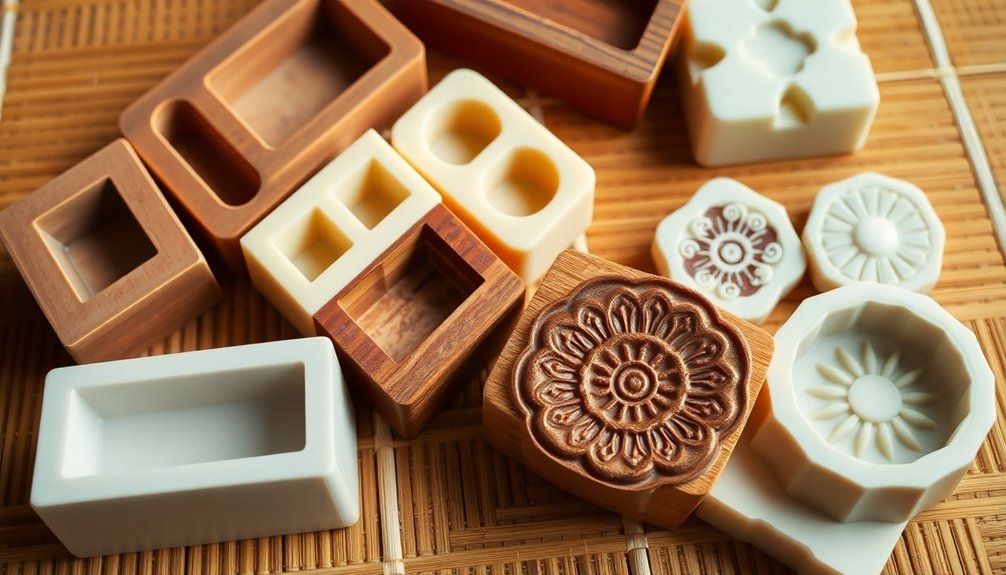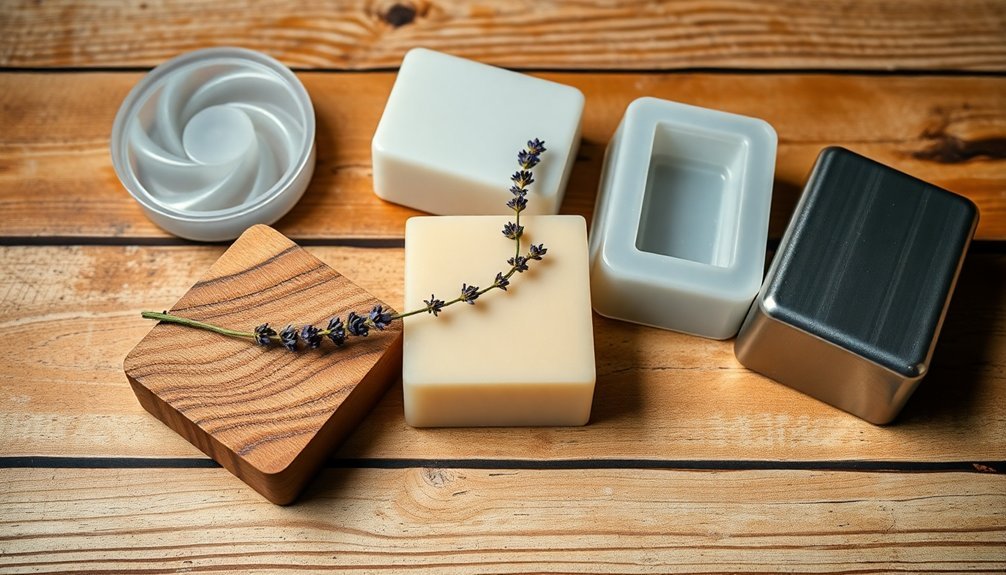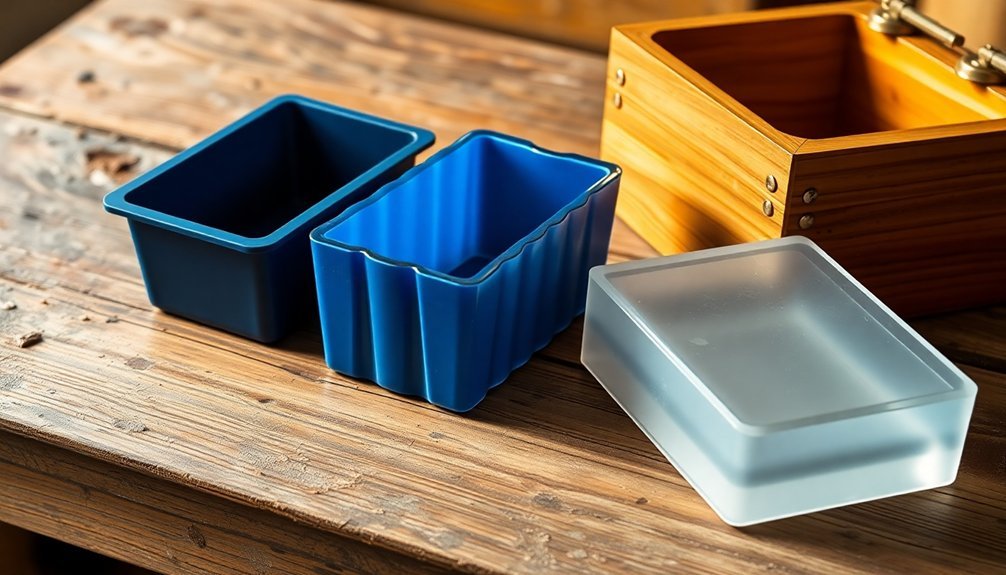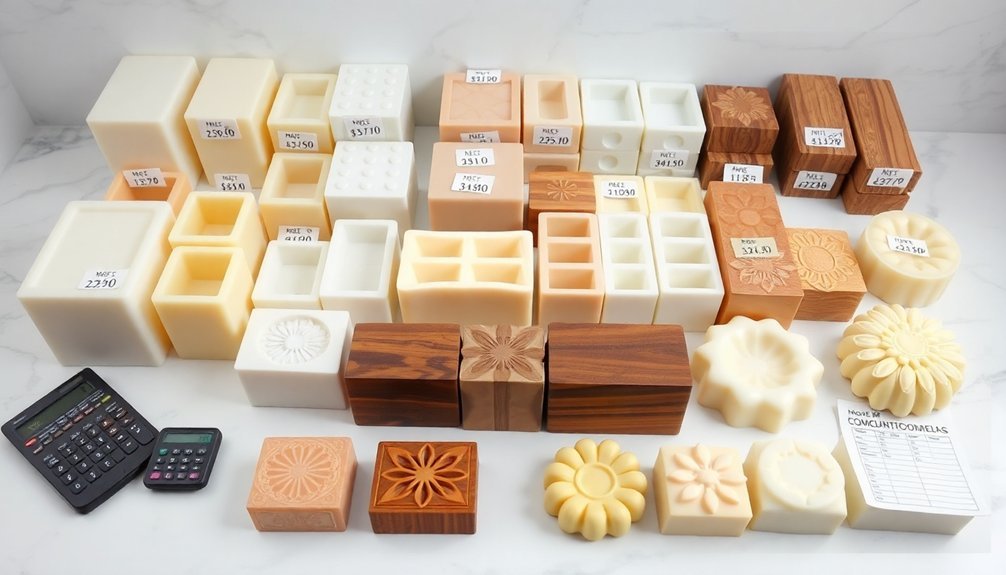When choosing professional soap molds, you'll need to evaluate the material type, size requirements, and production scale. Focus on high-quality materials like silicone, wood, or metal that offer heat resistance up to 400°F and non-stick properties for easy release. Calculate your batch volumes carefully – a standard 4-ounce bar needs 20 ounces of mold capacity for 5 bars. Your choice between materials affects both initial investment and long-term production efficiency. The following insights will help you make the most strategic selection for your soap-making business.
Essential Characteristics of Professional Soap Molds

When selecting professional soap molds, understanding their essential characteristics will make the difference between a successful production and frustrating setbacks.
You'll need to prioritize molds made from high-quality silicone, durable plastic, or sturdy wood to guarantee they'll withstand repeated use. The mold's non-stick surface is vital for easily releasing your soaps, especially when you're working with intricate designs.
Pay attention to heat resistance, as your molds must handle high temperatures during saponification without warping or compromising your soap's quality.
Heat-resistant molds are essential for successful soap making, protecting your product from warping and deformation during the intense saponification process.
Consider your production scale when choosing size and capacity. If you're planning bulk production, larger molds will streamline your process, while smaller ones work better for specialty items.
Whatever size you choose, guarantee the material and construction will maintain its integrity through multiple batches.
Understanding Different Mold Materials and Their Benefits

Each mold material brings distinct advantages to your soap-making process, making it essential to understand their unique properties before investing.
Silicone molds offer flexibility and non-stick properties, perfect for detailed designs and easy unmolding.
You'll find wooden molds excel in insulation properties, helping achieve ideal gel phase for larger batches, though they'll need liners and regular maintenance.
If you're looking for affordability, plastic molds come in various shapes but require careful handling to prevent soda ash and unmolding issues.
For high-volume production, metal slab molds deliver professional results and outstanding durability, despite needing liners and being heavier.
When selecting your mold, consider ease of use, maintenance needs, and batch size requirements.
Each material's unique characteristics will affect your final product's quality, so choose based on your specific soap-making goals and production scale.
Sizing and Capacity Requirements for Commercial Production

To determine your ideal soap mold capacity, you'll need to calculate your required batch volumes based on your weekly production targets and desired bar sizes.
You can scale up efficiently by selecting larger molds like metal slabs that produce 20-40 bars at once, or combine multiple silicone loaf molds that each yield 10-12 bars per batch.
When planning your production setup, factor in that a standard 4-ounce bar requires approximately 20 ounces of total mold capacity for every 5 bars you'll make in a batch.
Batch Volume Calculations
Understanding batch volume calculations is essential for successful commercial soap production. You'll need to match your mold capacity with your desired output while maintaining accurate measurements throughout the process.
| Mold Type | Typical Capacity |
|---|---|
| 10" Loaf | 2.5-3 lbs |
| Metal Slab | 5-10 lbs |
| 4-Cavity Silicone | 80 oz total |
| Single Cavity | 20 oz |
| Custom Large | 10+ lbs |
When planning your soap mixture, consider that different ingredients affect final volume. For layered soaps, divide your total batch volume by the number of layers you want to create. If you're using a standard loaf mold, you'll get approximately 8-10 bars, while commercial slab molds can produce 20-40 bars per batch. Remember to account for the density variations in your recipe to guarantee consistent results.
Production Scaling Strategies
Building on your batch volume knowledge, scaling up for commercial production requires strategic mold selection to maximize efficiency and output.
When planning production scaling, you'll need to take into account mold capacity that aligns with your target market demands. Metal slab molds and wooden molds are excellent choices for large batches, offering superior heat retention for consistent saponification.
Key considerations for scaling production include:
- Evaluate batch size requirements – metal slab molds produce 20-40 bars versus smaller 8-12 bar capacities
- Think about using disposable molds to reduce cleaning time between production runs
- Select molds that allow for customization options to diversify your product line efficiently
Evaluating Mold Durability and Longevity

When investing in professional soap molds, durability and longevity should be top priorities to maximize your return on investment. High-quality silicone molds offer the best value, lasting through hundreds of batches without degradation.
Silicone soap molds provide unmatched durability and value, delivering consistent results batch after batch while maintaining their quality over time.
While wooden molds can serve you well, you'll need to maintain them with regular oiling and freezer paper lining to guarantee their longevity.
Metal slab molds provide exceptional durability for large-scale production, though their weight and liner requirements may impact efficiency.
If you're considering plastic molds to save money, be aware that they're prone to cracking and warping, especially with hot soap formulations.
For the best long-term results, choose molds made from food-grade, BPA-free materials. This safety-conscious choice won't just protect your products—it'll also extend your molds' usable lifespan.
Cost Analysis: Investment vs. Production Output

A thorough cost analysis of soap molds reveals the direct relationship between initial investment and long-term production capacity.
While metal slab molds require a higher upfront investment of $80-150, they'll boost your production output to 20-40 bars per batch, making them an economical option for large-scale operations.
- Silicone molds offer lower initial costs but may require sodium lactate and longer production times.
- Wooden molds excel at handling large batches with good insulation, though ongoing maintenance affects total costs.
- Plastic cavity molds provide design flexibility with minimal investment but sacrifice unmolding efficiency.
When scaling your soap-making business, you'll need to weigh these factors carefully.
The right mold choice depends on your production goals, with higher-capacity options typically delivering better cost-per-unit ratios despite steeper initial investments.
Temperature Resistance and Insulation Properties
When making professional-quality soap, you'll need to take into account how your mold handles the critical heat reactions during curing, with silicone molds offering stability up to 400°F and wooden molds providing superior insulation.
You'll achieve the best gel phase results using either wooden or metal slab molds, which maintain consistent temperatures throughout the curing process.
If you're using loaf molds, you can enhance temperature control by wrapping them in towels or using heating pads to maintain the 140-170°F range needed for ideal saponification.
Heat Behavior During Curing
Understanding how your soap molds handle heat during the curing process is essential for achieving consistent, high-quality results. Each mold material interacts differently with heat, affecting your soap's gel phase and final appearance.
Silicone molds offer excellent heat resistance up to 400°F, while wooden molds provide natural insulation that helps prevent soda ash formation.
Key considerations for ideal heat behavior:
- Choose loaf molds for better heat retention and more uniform gel phase development.
- Enhance insulation by wrapping your molds with towels or using heating pads, especially during cooler seasons.
- Monitor metal molds closely, as they conduct heat rapidly and might require temperature adjustments.
You'll achieve better results by matching your mold's heat behavior to your specific soap-making needs, ensuring proper gel phase development and consistent curing throughout your batch.
Mold Material Heat Capacity
The heat capacity and temperature resistance of your soap mold material play an essential role in achieving professional results. You'll need to take into account how different mold materials handle temperature during the gelling process to guarantee ideal soap quality.
| Mold Material | Temperature Characteristics |
|---|---|
| Silicone | High heat resistance up to 400°F |
| Wood | Excellent natural insulation |
| Plastic | Limited heat tolerance, warping risk |
| Metal | High durability, poor insulation |
When selecting your mold material, remember that silicone molds offer superior heat resistance while maintaining shape integrity. Wooden molds provide natural insulation that's perfect for controlling the gelling process. You'll want to avoid plastic molds for hot processes, as they can't withstand extreme temperatures. While metal molds are durable, they'll need liners and may affect temperature distribution during curing.
Optimal Temperature Range Specs
Maintaining precise temperature control throughout the soap-making process requires molds that meet specific heat resistance and insulation requirements.
You'll need to take into account how different materials perform during the critical gelling temperature phase of 100°F to 130°F for ideal soap setting.
- Silicone molds withstand high temperatures up to 400°F, making them reliable for most soap-making processes without warping.
- Wooden molds excel at insulation, naturally maintaining temperatures around 110°F during the gel phase.
- Metal molds require additional insulation methods but offer excellent durability at high temperatures.
When you're selecting your mold, you'll want to verify it can maintain consistent heat distribution throughout the curing process.
Each material's unique insulation properties affect your soap's final appearance and texture, so choose based on your specific temperature control needs.
Maintenance and Cleaning Considerations
Proper care of your soap molds guarantees their longevity and the quality of future batches. To maintain your molds effectively, you'll need to thoroughly clean them after each use, removing all lye and soap residues that could contaminate future soaps.
For silicone molds, use a gentle saltwater and baking soda solution to remove lingering essential oil scents. This helps maintain their flexibility and non-stick properties without damaging the surface. Don't use harsh scrubbing tools, as they'll wear down the silicone.
When working with wooden molds, always line them with freezer paper to prevent soap from softening the wood and make cleanup easier.
To properly store your molds, keep them in a cool, dry space and avoid stacking heavy items on top, which can prevent warping and extend their useful life.
Design Features for Easy Soap Release
When selecting professional soap molds, you'll want to focus on features that make unmolding effortless, starting with a perfectly smooth inner surface that prevents soap from sticking or catching.
The strategic use of angled surfaces within the mold creates natural release points, making it easier to separate your finished soap from the mold walls.
Smart edge construction, including slightly rounded corners and tapered sides, guarantees your soap slides out cleanly while maintaining its intended shape.
Smooth Mold Surface Design
The smooth surface design of your soap mold plays a crucial role in achieving professional results. When you select a mold with non-stick surfaces, you'll guarantee your soaps release easily without damaging their appearance.
Silicone molds offer superior performance with their naturally smooth interior, while quality plastic molds should feature polished surfaces for ideal results.
To maximize your soap-making success, prioritize these essential surface features:
- Rounded corners and minimal texture to prevent soap from getting stuck in crevices
- Well-crafted, polished surfaces that create clean edges and professional-looking bars
- Non-stick properties that eliminate the need for additional release agents
Angled Release Features
Inside professional soap molds, angled release features act as essential design elements that simplify the unmolding process. You'll find these features create a slight slope that makes your soap bars easy to release without damage. When you're working with intricate molds, these angles help preserve fine details while minimizing the need for additional release agents.
| Feature | Benefit | Result |
|---|---|---|
| Tapered Edges | Easy Removal | Intact Soap Bars |
| Sloped Sides | Reduced Sticking | Smooth Process |
| Strategic Angles | Detail Preservation | High-Quality Finish |
Professional-grade soap molds with angled release features guarantee you'll get consistent, high-quality soap bars every time. These design elements make the unmolding process smooth and efficient, especially when you're working with detailed patterns that require extra care during removal.
Smart Edge Construction
Professional soap molds with smart edge construction revolutionize the unmolding process through innovative design features.
You'll find that durable molds with rounded or beveled edges make soap removal effortless while protecting your finished bars from damage. The incorporation of flexible materials like silicone, combined with non-stick surfaces, guarantees your soaps release cleanly every time.
Key features of smart edge construction include:
- Disassemblable sides and bottoms that provide multiple access points for gentle unmolding
- Built-in release mechanisms that prevent air and moisture from becoming trapped
- Easy cleaning surfaces treated for enhanced durability and professional finish
These thoughtful design elements work together to streamline your soap-making process, allowing you to maintain the integrity of your creations while achieving consistent, professional results with minimal effort.
Bulk Purchasing Strategies and Supplier Selection
When scaling up your soap-making business, smart bulk purchasing strategies can greatly reduce your mold costs while ensuring consistent quality.
Look for suppliers offering tiered discounts on larger quantities, as this can markedly lower your per-unit costs.
Smart bulk buying means seeking volume-based pricing tiers – your per-unit expenses drop significantly when purchasing larger quantities of supplies.
Before committing to bulk purchases, thoroughly research suppliers' reliability through customer reviews and ratings.
Request detailed product specifications and samples to evaluate mold durability and performance. You'll want to work with suppliers who provide responsive customer service and readily assist with any concerns.
Don't forget to examine shipping policies, as many suppliers offer free shipping on bulk orders, creating additional cost savings.
Building relationships with dependable suppliers who consistently deliver quality molds will help streamline your production process and maintain your product standards.
Quality Control Standards for Professional Molds
To maintain consistent product quality, soap molds must meet rigorous manufacturing standards and safety requirements. When evaluating professional molds for your soap-making venture, you'll need to verify they meet essential quality control benchmarks, including heat resistance up to 400°F and BPA-free certification.
Key standards you should check in professional molds:
- Material composition – verify they're made from food-grade silicone or durable plastics that are non-toxic and safe for repeated use.
- Surface quality – look for smooth surfaces and rounded edges that prevent soap damage during removal.
- Maintenance features – confirm they're easy to clean and don't retain odors or colors from previous batches.
Your molds' durability through multiple uses is vital for maintaining professional standards and consistent product quality.
Regular inspection of your molds will help guarantee they continue meeting these requirements.
Storage Solutions for Multiple Mold Types
Since proper storage extends the life of your soap molds, implementing an organized system for different mold types is crucial for your business success.
To prevent warping, store your silicone molds in a cool, dry place without stacking heavy items on top. You'll want to protect wooden molds from moisture by lining them with freezer paper and keeping them in well-ventilated areas.
Proper storage of silicone and wooden soap molds prevents damage and extends their lifespan – keep them cool, dry, and protected.
For plastic molds, store them upright in designated containers to prevent cracking, and make certain they're completely dry before storage.
Metal molds need special attention to avoid rust, so keep them in a dry environment and inspect them regularly.
Consider investing in a dedicated shelving unit as one of your primary storage solutions – it'll help you organize different mold types efficiently while preventing damage to your valuable equipment.
Customization Options for Brand Identity
Beyond proper storage, your soap molds can serve as powerful brand-building tools. Custom molds offer endless possibilities for enhancing brand identity through unique designs, logos, and signature soap shapes that'll set your products apart in the market.
You'll find that investing in customization helps create a professional image that attracts high-end clientele while reinforcing brand loyalty.
Consider these strategic customization approaches:
- Create seasonal-themed molds to align with promotional campaigns and boost market appeal
- Develop signature shapes that resonate with your target audience using clay or specialized materials
- Incorporate your brand elements through custom imprints that make your products instantly recognizable
For inspiration and technical guidance, you'll find valuable resources on platforms like Etsy and specialized soap-making forums, where artisans share their experiences with custom mold creation.
Safety Certifications and Material Compliance
Ensuring your soap molds meet essential safety standards isn't just a regulatory requirement—it's crucial for product quality and consumer trust.
When selecting professional molds, you'll need to verify they're made from food-grade materials that comply with FDA regulations. Look for safety certifications like LFGB or CE marking, which demonstrate adherence to strict European safety standards.
Your molds should be BPA-free to prevent harmful chemical leaching into your products. Check that your molds are heat-resistant up to 400°F to maintain material compliance during various soap-making processes.
Don't forget to review manufacturer documentation thoroughly—reputable suppliers will provide detailed information about their materials' safety testing and compliance standards. This transparency helps you maintain quality control and meet regulatory requirements while protecting your customers' well-being.
Frequently Asked Questions
What Are the Best Molds for Soap Making?
You'll find silicone molds are your best choice for soap making. They're flexible, non-stick, and easy to clean. For larger batches, consider wooden molds, while plastic cavity molds work great for decorative shapes.
How Do You Calculate Mold Capacity for Soap?
Measure your mold's length, width, and height in inches, then multiply them together. Convert the cubic inches to fluid ounces by multiplying by 0.554. That'll tell you how much soap your mold can hold.
What Is the Best Wood for Soap Molds?
You'll find non-treated pine is your best choice for soap molds, offering natural insulation and affordability. If you're looking for longevity, cedar's moisture resistance makes it an excellent alternative, despite its slight scent.
Do You Need to Grease Soap Molds?
You'll need to grease wooden and plastic soap molds to prevent sticking, but silicone molds don't require it. Just apply a light layer of oil or non-stick spray on non-silicone molds before use.
In Summary
Selecting professional soap molds requires careful consideration of materials, size requirements, and long-term durability. You'll need to balance your initial investment against production goals while ensuring all molds meet safety standards. Don't forget to factor in storage space and customization options for your brand. With proper research and attention to these key factors, you'll find the perfect molds for your soap-making business.





Leave a Reply